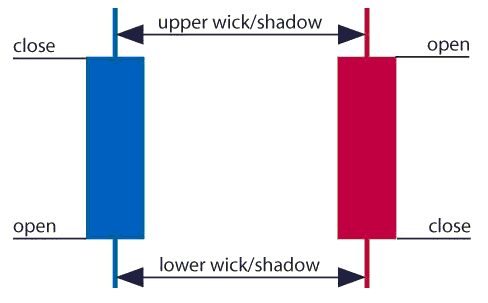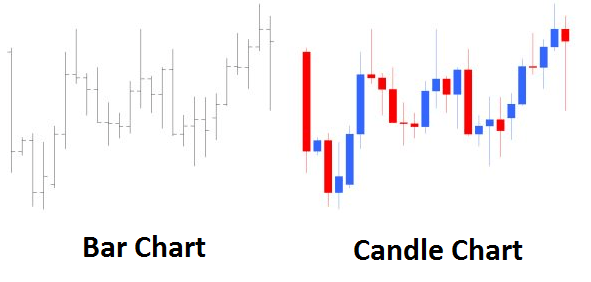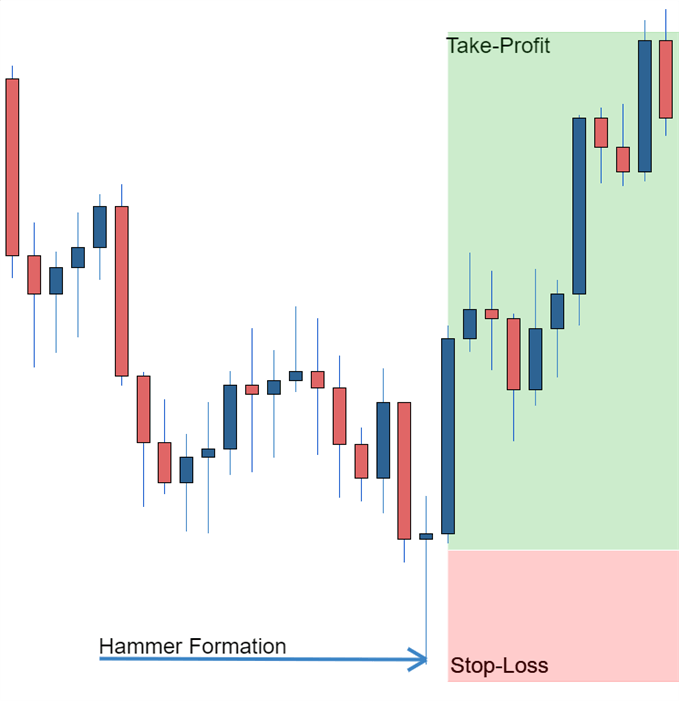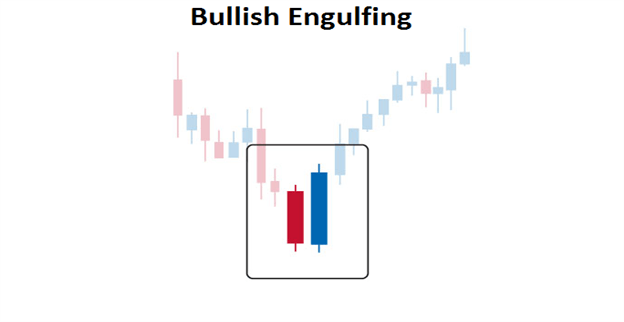How to Read Bond Markey Tables High Low Last Change
- Reviewed by James Stanley, Dec. 15, 2021
Reading candlestick charts – Talking points:
- Candlestick charts differ greatly from the traditional bar nautical chart
- Traders generally prefer using candlestick charts for day-trading considering they offer an enjoyable visual perception of price
- Information technology's important to sympathize the key components of a candle, and what they indicate, to apply candlestick chart analysis to a trading strategy
What is a candlestick chart?
A candlestick chart is but a chart composed of private candles, which traders use to understand toll action. Candlestick price action involves pinpointing where the toll opened for a period, where the price closed for a menstruum, as well as the price highs and lows for a specific menstruation.
Price action can give traders of all financial markets clues to tendency and reversals. For example, groups of candlesticks tin can form patterns which occur throughout forex charts that could indicate reversals or continuation of trends. Candlesticks can also form individual formations which could bespeak buy or sell entries in the market.
The menstruum that each candle depicts depends on the time-frame chosen past the trader. A popular time-frame is the daily time-frame, so the candle will depict the open, close, and high and low for the day. The different components of a candle tin assistance you forecast where the toll might go, for instance if a candle closes far below its open up information technology may signal further toll declines.
Boost your nautical chart patterns expertise with our interactive quiz!
Our Forex Trading Patterns Quiz will test your knowledge of some of the virtually important trading patterns. Accept the test today by clicking on the link and raise your technical assay game!
Interpreting a candle on a candlestick chart
The image beneath represents the design of a typical candlestick. There are three specific points (open, close, wicks) used in the creation of a price candle. The first points to consider are the candles' open and close prices. These points place where the price of an asset begins and concludes for a selected period and will construct the trunk of a candle. Each candle depicts the price movement for a certain period that yous choose when you look at the chart. If y'all are looking at a daily chart each private candle will brandish the open, close, upper and lower wick of that day.

Open price:
The open price depicts the first cost traded during the formation of the new candle. If the price starts to trend upwards the candle will plow green/blue (colors vary depending on chart settings). If the price declines the candle will turn red.
High Price:
The acme of the upper wick/shadow indicates the highest price traded during the flow. If there is no upper wick/shadow it means that the open cost or the close price was the highest price traded.
Low Price:
The lowest toll traded is the either the price at the lesser of the lower wick/shadow and if there is no lower wick/shadow and so the lowest cost traded is the same every bit the close price or open price in a bullish candle.
Close Price:
The shut toll is the concluding toll traded during the catamenia of the candle formation. If the close cost is below the open cost the candle will turn red equally a default in nearly charting packages. If the shut price is above the open price the candle will be green/bluish (also depends on the chart settings).
The Wick:
The side by side important element of a candlestick is the wick, which is too referred to as a 'shadow'. These points are vital as they show the extremes in price for a specific charting period. The wicks are quickly identifiable as they are visually thinner than the body of the candlestick. This is where the strength of candlesticks becomes apparent. Candlesticks can help traders continue our centre on market momentum and away from the static of cost extremes.
Management:
The direction of the toll is indicated past the color of the candlestick. If the toll of the candle is closing above the opening price of the candle, and then the price is moving upwards and the candle would be dark-green (the colour of the candle depends on the chart settings). If the candle is red, and so the price closed below the open up.
Range:
The difference between the highest and everyman price of a candle is its range. Yous can calculate this past taking the price at the pinnacle of the upper wick and subtracting it from the toll at the lesser of the lower wick. (Range = highest bespeak – lowest point).
Having this cognition of a candle, and what the points indicate, ways traders using a candlestick chart have a clear advantage when it comes to distinguishing trendlines, toll patterns and Elliot waves.
Bar Chart vs Candlestick Chart
Equally you can meet from the image below, candlestick charts offer a distinct advantage over bar charts. Bar charts are not as visual as candle charts and nor are the candle formations or price patterns. Likewise, the bars on the bar chart arrive difficult to visualize which direction the cost moved.

How to read a candlestick chart
There are various ways to use and read a candlestick nautical chart. Candlestick chart analysis depends on your preferred trading strategy and time-frame. Some strategies endeavour to take advantage of candle formations while others attempt to recognize cost patterns.
Interpreting unmarried candle formations
Individual candlesticks can offer a lot of insight into current market sentiment. Candlesticks similar the Hammer , shooting star , and hanging man, offering clues as to changing momentum and potentially where the market prices maytrend.
As you lot can run into from the image below the Hammer candlestick formation sometimes indicates a reversal in trend. The hammer candle formation has a long lower wick with a small body. Its closing pricing is above its opening price. The intuition backside the hammer formation is simple, price tried to refuse simply buyers entered the market pushing the toll upwards. It is a bullish signal to enter the market place, tighten stop-losses or close out a brusk position.
Traders can take advantage of hammer formations by executing a long merchandise once the hammer candle has closed. Hammer candles are advantageous considering traders tin can implement 'tight' stop-losses (terminate-losses that risk a small amount of pips). Take-profits should exist placed in such a fashion as to ensure a positive risk-advantage ratio. So, the accept-profit is larger than the stop-loss.

Recognizing price patterns in multiple candles
Candlestick charts help traders recognize price patterns that occur in the charts. Past recognizing these price patterns, similar the bullish engulfing pattern or triangle patterns you tin can take advantage of them by using them every bit entries into or go out signals out the market place.
For example, in the epitome beneath we have the bullish engulfing price pattern. The bullish engulfing is a combination of a red candle and a blue candle that 'engulfs' the entire ruby-red candle. It is an indication that information technology could be the end of a currency pairs established weakness. A trader would take advantage of this past inbound a long position after the blue candle closes. Remember, the toll pattern simply forms once the second candle closes.
As with the hammer formation, a trader would place a stop loss beneath the bullish engulfing pattern, ensuring a tight stop loss. The trader would then set a have-profit. For more than forex candlestick charts check our forex candlesticks guide where nosotros become in depth into the advantages of candlestick charts as well as the strategies that can be implemented using them.

Further tips for reading candlestick charts
When reading candlestick charts, be mindful of:
- The time frames of trading.
- Classic price patterns.
- Price activity.
At DailyFX we offering a range of forecasts on currencies, oil, equities and gold that tin aide you in your trading. It is besides worth following our webinars where nosotros present on a variety of topics from cost-action to fundamentals that may impact the market.
DailyFX provides forex news and technical analysis on the trends that influence the global currency markets.
Source: https://www.dailyfx.com/education/candlestick-patterns/how-to-read-candlestick-charts.html
Postar um comentário for "How to Read Bond Markey Tables High Low Last Change"